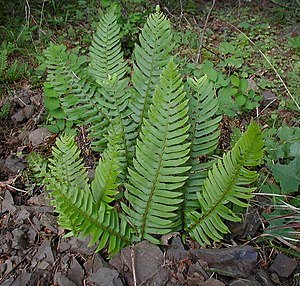Western sword fern
| Western sword fern | ||||||||||||
|---|---|---|---|---|---|---|---|---|---|---|---|---|

Western sword fern in the Columbia River Gorge |
||||||||||||
| Systematics | ||||||||||||
|
||||||||||||
| Scientific name | ||||||||||||
| Polystichum munitum | ||||||||||||
| ( Kaulf. ) C. Presl |
The West American sword fern ( Polystichum munitum ) is an evergreen fern that is native to western North America . There it is one of the most common ferns.
features
The dark green fronds of this fern are 50–180 cm long and sprout as a compact structure radially from a round base. They are simply pinnate , with the individual leaflets arranged alternately. The feathers are 1–15 cm long with a small upward-pointing lobe (similar to a sword hilt - hence the name) at the base. The edges are sawn and have bristly tips. Individual fronds live for one and a half to two and a half years and remain attached to the rhizome even after they have dried out . The round sori occupy two rows on either side of the midrib of each leaflet and are covered by a central umbrella-like indusium with fringed edges. They produce light yellow spores.
distribution and habitat

The Western American sword fern occurs along the coast from southeast Alaska to southern California . Inland, it is found in southeastern British Columbia , northern Idaho, and western Montana ; there are also isolated populations in northern British Columbia, a single occurrence in the Black Hills in South Dakota and on the Mexican island of Guadalupe west of the Baja California peninsula (here partly understood as a separate species Polystichum solitarium Maxon ).
The preferred habitat of this fern is the understory of moist coniferous forests at low altitudes. It thrives best on well-drained acidic soils with high humus and low stone content. Sword ferns are very robust and can withstand sudden dry spells, but prefer cooler weather with even moisture and bright sunlight. The fern is able to absorb large amounts of moisture through its leaves from fog. When cultivated, they also respond positively to low fertilizers. The species occurs vicariously with the closely related and similar Polystichum imbricans , with Polystichum munitum occupying the darker and more humid locations . In the transition zones between the preferred habitats of both species, hybrids between them appear.
While this fern is the preferred cultivator in western North America, it has proven difficult or impossible to achieve satisfactory results in the eastern part of the continent.
use
In the spring, when nothing else was available, the fern was traditionally used as a food by various tribes of the Indians , namely the Quileute , Makah , Klallam , Squamish , Sechelt and Haida . For this, the rhizomes were roasted and peeled and eaten like that.
The plant is widely used as a green plant by florists and gardeners.
Phylogeny and Systematics
According to genetic data, the sister species of Polystichum munitum is the West American, morphologically quite similar Polystichum imbricans , with which it can also form hybrids . Both species belong to an almost worldwide common clade that also includes numerous species from the Old World.
Individual evidence
- ↑ Plants Profile for Polystichum munitum (western swordfern) . In: PLANTS database . United States Department of Agriculture, Natural Resources Conservation Service. 2017. Retrieved November 2, 2017.
- ^ Ralph Brooks (1968): Polystichum munitum in South Dakota. American Fern Journal 58: 92-92. scan online at biostor.org
- ↑ Emily B. Limm & Todd E. Dawson (2010): Polystichum munitum (Dryopteridaceae) varies geographically in its capacity to absorb fog water by foliar uptake within the redwood forest ecosystem. American Journal of Botany 97 (7): 1121-1128. doi: 10.3732 / ajb.1000081
- ↑ Edward K. Kentner & Michael R. Mesler (2000): Evidence for natural selection in a fern hybrid zone. American Journal of Botany 87 (8): 1168-1174.
- ↑ Paul Alaback, Joe Antos, Trevor Goward, Ken Lertzman, Andy MacKinnon, Jim Pojar, Rosamund Pojar, Andrew Reed, Nancy Turner, Dale Vitt: Jim Pojar and Andy MacKinnon (Eds.): Plants of the Pacific Northwest Coast , Revised. Edition, Lone Pine Publishing, Vancouver, British Columbia 2004, ISBN 978-1-55105-530-5 , p. 53.
- ↑ Heather E. Driscoll & David S. Barrington (2007): Origin of Hawaiian Polystichum (Dryopteridaceae) in the context of a world phylogeny. American Journal of Botany 94 (8): 1413-1424. doi: 10.3732 / ajb.94.8.1413